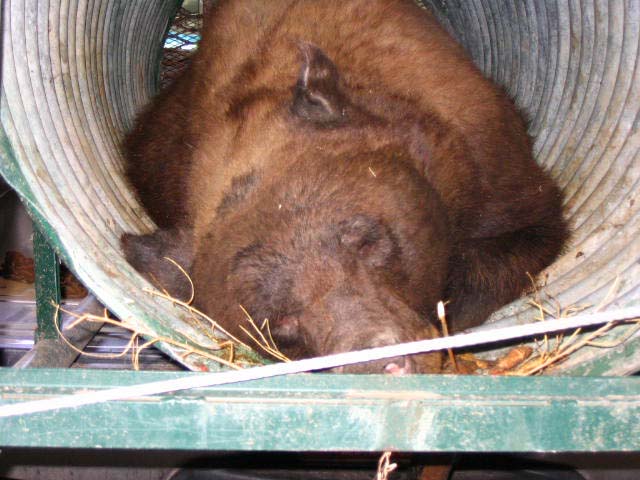A fed bear is a dead bear, according to Manny L’Esperance of Response Services (ER-RS), the Laboratory’s commissioned conservation game and fish officer.
L’Esperance said he has responded to employee concerns that bears are rummaging through trashcans and looking for food wherever they can find it. Employees have seen bears or the evidence of bears at Technical Areas 54 and at S-Site.
Black bears naturally have a fear of humans, but the scent of easily obtained food is irresistible to bears and can radically alter their behavior. The best avoidance method is prevention; remove all sources of human-provided food, said L’Esperance.
In the spring, a black bear’s diet is fresh forbs and grasses, young succulent shoots, roots, insects, and carrion. In summer, they eat young grasses, insects, berries, and fruit. But in late summer, if there isn’t enough food or if their late summer diet consisting of nuts and berries hasn’t developed, the bears will look for food wherever opportunity takes them. In late August, they begin looking for food that will enable them to rapidly gain weight so they can survive the denning season. Bears will look for nuts, such as acorns and piñons, juniper berries, maggots, ants, and small rodents.
Female bears give birth in January or February to one or two cubs. Newborns are about the size of a mouse. When they leave the den in April or May, the cubs may weigh six or seven pounds. By late fall, the cubs will weigh from 40 to 70 pounds. Cubs are weaned at seven months old, but remain with their mother until their second spring.
Historically, both black bears and grizzlies lived in New Mexico, but the last grizzly was killed in the 1930s. New Mexico’s black bear population is estimated at 5,000.
Problem bears can’s simply be relocated, L’Esperance said. If a bear tries to move in on another bear’s territory, it’s immediately chased away and may even be killed by the resident bear. The New Mexico Game and Fish Department says it cannot simply drive a problem bear 200 miles and “dump” the bear, because other, resident bears will likely kill it. Most problem bears are young bears. New Mexico law prohibits the feeding of bears, both directly and indirectly.
To avoid bear problems this year, Game and Fish provides the following tips:
• Keep pet food inside.
• Bring in birdseed and hummingbird feeders at night.
• Keep the garbage cans bear-proof by attaching chains to hooks or purchasing bear-proof cans.
Employees can call Emergency Response at 7-6211 if they see a bear. Employees should do the following:
• Stay calm.
• If the bear hasn’t seen you, calmly move away and leave the area. As you move away, talk softly to let the bear discover your presence.
• Do not approach the bear, back away slowly while facing the bear. Do not make any sudden movements.
• Avoid eye contact with the bear, as bears may perceive this as a threat. Speak softly; don’t scream.
• Bears sometimes run from humans, but if it feels cornered or threatened, it could attack.
• Fight back if attacked by a black bear. Black bears have been driven away when people have fought back with rocks, sticks, binoculars, and even with their bare hands. Spraying cayenne pepper in the face (at close range) of an attacking bear can stop an attack.
• If you do encounter a bear, savor the experience. Many people will never in their lifetime have the opportunity to observe such a majestic animal in the wild.


